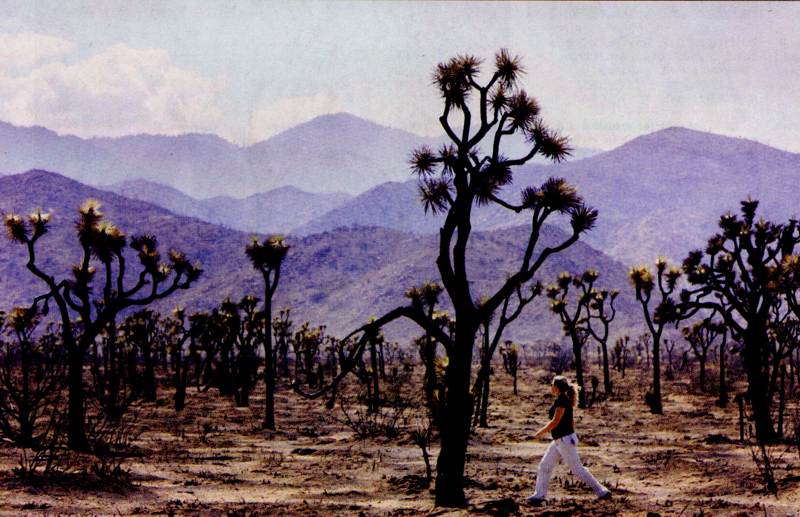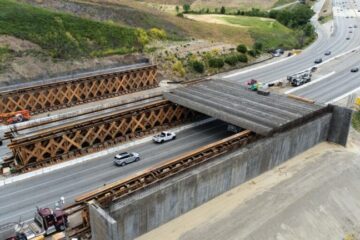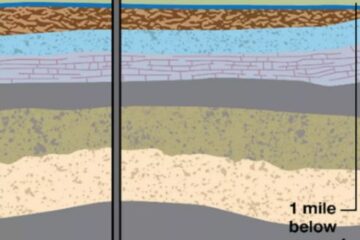Desert Fires’ Damage Will Last
It will take centuries for plant life to recover. Many experts say invasive vegetation is largely to blame.<
Source of this article – Los Angeles Times, August 21, 2006.
By Janet Wilson, Times Staff Writer
April Sall stood in the charred remnants of a Joshua tree forest, bark peeling off melted black limbs. Above her, ridges once thick with 1,000-year-old piñon and juniper pines were scorched bedrock and stumps.
More than 90% of the surrounding Pipes Canyon Preserve was consumed in last month’s Sawtooth blaze. It was one of half a dozen fast-moving fires this summer that burned 65,000 acres of the Mojave Desert, fueling debate over whether the desert is burning more frequently and explosively as a result of invasive weeds, smog, development and climate change.
FOR THE RECORD:
Desert fires: An article in Monday’s California section about fires in the desert identified a species of bird as a logger-headed shrike. It is a loggerhead shrike. Also, the article referred to a danger posed to some young trees by “thirsty rodents and ground squirrels.” Ground squirrels are rodents. —
“It’s heartbreaking to see,” said Sall, a biologist who manages the preserve and whose grandmother homesteaded the land a century ago. “We’ll never see those piñon or juniper trees again in our lifetimes, nor will our children, nor will their grandchildren. It’s a bitter pill…. This land isn’t meant to burn.”

FIRE’S PATH: April Sall is a biologis and manager of the Pipes Canyon Preserve, which was 90% burned in last month’s Sawtooth fire. It claimed the Joshua trees shown, as well as 1,000-year-old pinon and juniper pines. “This land isn’t meant to burn,” she says. (Irfan Khan, Los Angeles Times)
Many scientists agree, saying the recent blazes offer fresh evidence that deserts across the Southwest are undergoing a profound shift, as ancient native pine, shrubs and cactuses give way to young, highly flammable weeds and grasses.
“Right now we’re losing very large pieces of landscape,” said Todd Esque, an ecologist with the U.S. Geological Survey in Henderson, Nev., who studies the cause and effect of fires in the desert. “It’s happening in Joshua Tree National Park, it’s happening in Mojave National Preserve … up in southwestern Utah … and in Arizona. We lost 750,000 acres of desert to fire in Nevada alone last summer.”

FUEL: Greg Hill of the Bureau of Land Management strolls Big Morongo Canyon Preserve, where fire didn’t strike. The gold-colored, nonnative chatgrass readily burns.
This summer, five blazes have seared parts of Joshua Tree, where a fire only every few years was the norm for the last 50 years.
Esque and other researchers say that unlike forests and chaparral, the sparsely vegetated desert is not meant to burn frequently.
“The public has come to understand that fire is a necessary part of the life of forests,” Esque said. “That is not the case with deserts. We have a major problem going on.”
A vocal minority disagrees, contending there is no clear-cut evidence of far-reaching change. They blame this year’s fires on bumper crops of wildflowers nourished by heavy spring rains two years ago. According to the theory, dried remnants of the prolific blooms fueled a 50,000-acre fire in the Mojave National Preserve last summer and in this year’s conflagrations.
“The winter of 2004-05 was the wettest ever in 100 years of recorded data in the desert. We had a phenomenal crop of annual native wildflowers, and it was dry the next year and it stayed there,” said Richard Minnich, a professor of Earth sciences at UC Riverside. “It’s flash fuel of 1 to 2 tons per acre. What’s really scary is, there’s still a lot of it out there.”
Scientists do agree that it will take centuries, if not millenniums, for the desert to recover.
“It won’t be on a timeline we humans would like, but it will happen,” said Tasha LaDoux, Joshua Tree National Park’s botanist.
Inside the park, new growth provides fodder for the debate over whether the fragile, arid landscape is undergoing dramatic change.
At the scene of a 1995 fire, not a single juniper or piñon pine seedling has come up after 11 years. But healthy, 3-foot “pups” have sprouted from the roots of once seemingly dead Joshua trees. The pups may or may not survive, scientists say, because in drought years they may be gnawed by thirsty rodents and ground squirrels. Meanwhile, native apricot mallow, bright-green cheesebush and golden California marigold are blooming even in August.
Along a sandy road in the western section, the scene of a 1999 blaze that scorched 14,000 acres, a beige sea of grasses spreads beneath burned Joshua trees bleached silver by sun and rain. The new growth consists of native bunch grasses and a pair of noxious, ankle-scratching weeds.

CHEATGRASS: The invasive weed is blamed for much of the damage caused by this summer’s desert wildfires.
These two nonnatives, known as red brome and cheatgrass, form highly flammable carpets between native shrubs and trees, and many scientists believe they are the main culprits behind increasing fires.
“These invasive grasses fill in the spaces between the desert plants. They carry the flame through at a very high rate, and much hotter. It spreads a lot faster,” Sall said.
The weeds are also bad for animals.
“The ranchers call it cheatgrass because for the first few years it’s good grass, but after that it cheats the cattle of their nutrients,” Esque said.
Native to Mediterranean Europe and Asia, the weeds were probably blown across the West by the wind, tracked in by hikers’ boots and construction equipment, and excreted by livestock. Researchers at UCLA and elsewhere say the weeds appear to capture nitrogen from smog-laden air more readily than native plants, eventually choking them out.
But Minnich of UC Riverside said years of drought had actually caused most of the red brome to die out, while annual native grasses remain safely stored in natural seed banks on adjoining, unburned islands of habitat.
Richard Halsey couldn’t disagree more.
“You’re going to see a solid blanket of yellow felt next year,” he said, meaning a blanket of dried nonnative grasses. Halsey, a former biology teacher who is now a researcher and firefighter, was asked by the U.S. Bureau of Land Management to evaluate the role of vegetation in the Sawtooth fire.
“No one else on the planet agrees with Rich Minnich,” Halsey said. “I went out there during the fire and after the fire and looked…. Not only didn’t I see the volumes of wildflowers he’s talking about, but in the burn area specifically…. I had a hard time finding natives. The predominant fire fuel mix was cheatgrass and red brome.”
Robert Webb, a hydrologist with the Geological Survey’s Tucson office who has studied botany in the Mojave for 30 years, laughed when he heard about the debate.
“The truth is, they may all be right. The desert is very complicated. There is incredible local variability,” he said. Echoing other scientists, he said, “Minnich often heaves these ideas out there that are different…. It’s healthy, it makes us all look very carefully at our own data.”
Webb is writing a paper with other researchers that looks at three post-fire scenarios for the Mojave, all plausible, all different. Rather than focusing on Joshua trees or pines, they studied ancient black brush, a gray-brown shrub that has evolved to withstand desert temperatures and scarce rain.
A single bush can survive thousands of years. But it is highly flammable, proof to Webb that fire is not natural in the desert. One scenario does show nonnatives replacing black brush and causing more frequent fires. But he said data gathered so far made that scenario “only slightly more likely” than two others in which black brush grows back.
“Some of those Joshua trees may sprout too,” Wall said, referring to the Pipes Canyon Preserve. “They’re an amazing tree.”
But others say such a destructive fire in a preserve like Pipes Canyon did lasting harm.
Tom Scott, a zoologist affiliated with UC Berkeley and UC Riverside, said the canyon preserve encompassed “one of the greatest transition zones in North America. If you look at where it starts way up on top of the San Bernardino Mountains, and then descends down to the desert, you’re covering this incredible array of habitats, from montane forest down to low desert.”
Scott said there were probably smaller pockets of plants and animals that evolved over millenniums in nooks in the preserve, only to be wiped out by this summer’s catastrophic fire.
“If we’ve introduced grasses that are driving fire much further than it used to go, and you’ve got a lot of these small patches that are really unique in terms of species, then you’re erasing them with large conflagrations,” he said.

When deserts burn
The 61,700-acre Sawtooth blaze was the largest of six fires in July in California’s High Desert. Many experts fear that more fires in deserts, which they say are not adapted to flame, will harm landscapes that could take millenniums to recover.
Sources: Mountailn Area Safety Task Fource, California Department of Forestry and Fire Protection, Google Earth
Esque worries about vulnerable desert species such as the reclusive desert tortoise, Scott’s oriole, logger-headed shrike and least Bell’s vireo songbirds, as mature shrubs that offered shelter are replaced with grasses.
“When you have less cover, with that goes less diversity,” he said.
Webb is most concerned about warming temperatures in the desert. Besides causing less winter snow, warmer weather generates more summer thunderstorms and lightning strikes. Lightning started all the fires that ravaged Pipes Canyon Preserve and Joshua Tree National Park this summer.
Others said urbanization, motorized recreation and military activities were also taking a toll on the natural desert.
“What will be the one thing that does in the desert as we know it? It’s not one thing. It’s the onslaught of all these things,” Esque said. He said there was little that could be done to turn back the clock. Many nonnative weeds are too far spread to be dug out, while native seeds are not widely available and can cost millions of dollars to gather and plant.
Beyond planting a bit of native seed, Sall said, she plans to let Pipes Canyon come back on its own, however long it takes.
Greg Hill of the Bureau of Land Management’s Palm Springs office said his agency will take a similar approach to other burned areas in the desert.
“We’ll let it regenerate naturally,” he said. “It’s the largest big chunk of undeveloped land left in Southern California.”



0 Comments